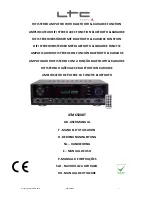
TROUBLESHOOTING and MAINTENANCE
Operating Manual No: PWOM-215/250MP-001
Page 32
© 2018 Global Welding LLC
6.2
STICK Welding Troubleshooting
NOTE
21:
Weld quality is dependent on the correct consumables, proper welding technique and equipment maintenance
Description
Possible Cause
Remedy
1.
Porosity: gas holes or voids in weld
metal.
A
Electrodes are damp.
B
Welding Amperage is too high.
C
Surface impurities such as oil, grease,
paint, etc.
A
Dry electrodes before use.
B
Reduce Welding Amperage.
C
Clean joint before welding
2.
Crack occurring in weld metal soon
after solidification commences.
A
Rigidity of joint.
B
Insufficient throat thickness.
C
Cooling rate is too high.
A
Redesign to relieve weld joint of severe
stresses or use crack resistance electrodes.
B
Travel slightly slower to allow greater build
up in throat.
C
Preheat plate and cool slowly.
3.
A gap is left by failure of the weld metal
to fill the root of the weld.
A
Welding Amperage is too low.
B
Electrode too large for joint.
C
Insufficient gap.
D
Incorrect sequence.
A
Increase Welding Amperage
B
Use smaller diameter electrode.
C
Allow wider gap.
D
Use correct build-up sequence.
4.
Portions of the weld run do not fuse to
the surface of the metal or edge of the
joint
A
Small electrodes used on heavy cold
plate.
B
Welding Amperage is too low.
C
Wrong electrode angle.
D
Travel speed of electrode is too high.
E
Scale or dirt on joint surface.
A
Use larger electrodes and pre-heat the plate.
B
Increase Welding Amperage
C
Adjust angle so the welding arc is directed
more into the base metal
D
Reduce travel speed of electrode
E
Clean surface before welding.
5.
Non-metallic particles are trapped in the
weld metal (slag inclusion).
A
Non-metallic particles may be trapped in
undercut from previous run.
B
Joint preparation too restricted.
C
Irregular deposits allow slag to be
trapped.
D
Lack of penetration with slag trapped
beneath weld bead.
E
Rust or mill scale is preventing full
fusion.
F
Wrong electrode for position in which
welding is done.
A
If bad undercut is present, clean slag out and
cover with a run from a smaller diameter
electrode.
B
Allow for adequate penetration and room for
cleaning out the slag.
C
If very bad, chip or grind out irregularities.
D
Use smaller electrode with sufficient amper-
age to give adequate penetration. Use suita-
ble tools to remove all slag from corners.
E
Clean joint before welding.
F
Use electrodes designed for position in
which welding is done, otherwise proper
control of slag is difficult.
6.
Difficult to establish an arc.
A
Loose connections in welding leads.
B
Metal is contaminated with oil or rust or
grease or dirt.
A
Check all welding leads electrical connec-
tions for defects like burnt or discoloration
connections. Replace/replace electrical con-
nections or welding leads.
B
Clean metal to remove contamination.
7.
The arc wanders away from the
joint during welding (Arc Blow).
A
Air movement is pushing the arc.
B
The coating on the stick electrode isn’t
even around the metal core.
C
Welding Amperage passing thru the
metal sets up a magnetic field which
pushes the arc.
A
Shield the weld zone from the air movement.
B
Use a new electrode from another batch.
C
Reposition the Earth Clamp position to re-
duce this affect.









































